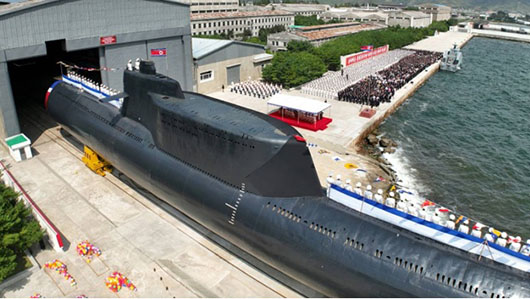FPI / September 13, 2023
By Richard Fisher
On Sept. 6, amid a broadcast North Korean ceremony, dictator Kim Jong-Un presided over the official launch ceremony of his new large conventionally-powered ballistic-missile-armed submarine (SSB), called “841,” and suggested it may be the first of many, posing an increasing regional nuclear and a global proliferation threat.

The U.S. response to the revival of the China-Russia-North Korean alliance, last seen during the Korean War, was to dispatch a diplomat to Seoul for consultations.
A program that likely began construction in the early to mid-2010s, North Korean images from July 2019 first revealed this submarine as being partially built, with only indications that it would emerge with an elongated “sail” that would contain multiple missiles.
On Sept. 8, North Korean state media reported that Kim Jong-Un noted the submarine had the “capability to execute preemptive and retaliatory strikes against hostile countries from any underwater location, while carrying a substantial arsenal of nuclear delivery vehicles, each with varying yields.”
Clear images released by North Korean state media show it is at least armed with ten missiles, with four larger tubes likely containing 600-kilometer range KN-23 short range submarine launched ballistic missile (SLBM), first launched from the smaller Sinpo-class North Korean missile submarine in October 2021.
Capable of flying a “depressed trajectory” to better evade radar and missile defenses, the KN-23 can be armed with North Korea’s new Hwasal-31 tactical nuclear warhead.
The new submarine sail also has six tubes that likely are for North Korea’s new Hwasal-1/2, a new 1,500-2,000 km-range land attack cruise missile (LACM) that on March 13 were launched from the smaller Sinpo-class submarine.
This cruise missile can also be armed with the Hwasal-31 tactical nuclear warhead.
Analysts have long speculated that the new “Sinpo-C” SSB is an extensively modified version of the Chinese-designed and built Type-033 conventionally powered submarine, 20 of which were acquired directly from China, and also assembled in North Korea.
It is almost certain that China contributed design and construction assistance, even manufactured parts for the new North Korean nuclear missile submarine.
The North Korean submarine’s sail is a dead ringer for the China Shipbuilding Industry Corporation (CSIC) “S1101,” a small 1,100-ton export conventional submarine revealed in 2017.
While China has not built, acquired or sold this submarine yet, using this sail design on the new North Korean submarine would be consistent with longstanding Chinese deception methods of building unique weapons to conceal its export of nuclear capable weapon systems.
Full Report . . . . Current Edition . . . . Subscription Information
Free Press International
